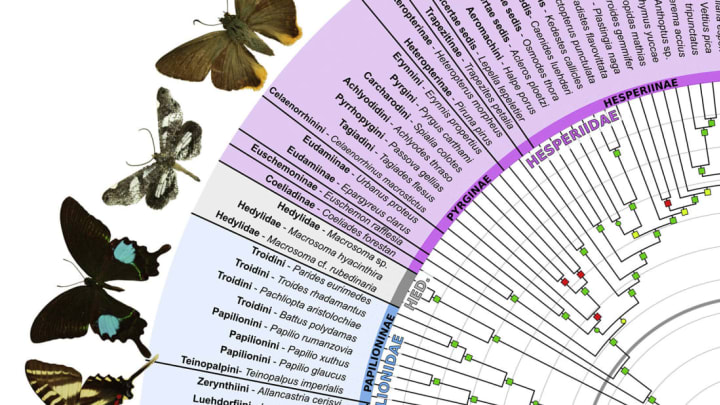There are 18,000 known butterfly species in the world, so maybe it’s not surprising that scientists haven’t quite worked out how they’re all related. Recently, scientists developed what is currently the most comprehensive roadmap of butterfly evolution ever, one that includes 35 times more genetic data and three times as many classifications as past butterfly evolutionary trees. Oh, and as Fast Company found, it’s beautiful.
The study, published in Current Biology, drew on genetic data from 207 butterfly species that together represent 98 percent of butterfly tribes (the classification just above genus). Led by Florida Museum of Natural History curator Akito Kawahara and Marianne Espeland of the Alexander Koenig Research Museum in Germany, the study used this genetic data and the fossil record to trace the evolution of different butterfly species and figure out when different species split off from their cousins.

Needless to say, millions years of evolution means a lot of information to visualize in one family tree. Each bold label on the very outside of the circle represents a tribe, like Tagiadini, followed by the individual species that made it into the study, like Tagiades flesus (the clouded skipper). Species are clumped together by subgroup—in this case, Pyrginae (spread-winged skippers)—and color-coordinated by family—in this case, Hesperiidae (skippers).
The solid gray circle near the center, labeled K-PG boundary (for Cretaceous–Paleogene boundary) represents the mass extinction event that killed off most of Earth’s plant and animal species, including the dinosaurs.

The study confirms several pieces of information that butterfly experts had hypothesized about in previous studies, while overturning other hypotheses. Butterflies can be divided into seven different families, and though previous research estimated that the first butterflies appeared around 100 million years ago, this study pushes that date back to around 120 million years ago. But there were just a few early ancestors of butterflies prior to the mass extinction event that wiped out the dinosaurs, after which the butterfly family tree explodes into different branches.
Swallowtail butterflies (the subfamily Papilioninae, to the left in blue) were the first butterfly family to branch off, so they’re a “sister” species to all other butterfly species. Skippers (the family Hesperiidae, in purple) likely branched off next, then nocturnal butterflies like the Hedylidae family (in gray). However, some species that scientists previously thought were sister groups do not, in fact, share common ancestry, including swallowtails, birdwings, zebra swallowtails, and swordtails. The timeline shows that some butterfly species seem to have evolved together along with the plants they feed on or, in some cases, ant species with which they now have a mutually beneficial relationship.
[h/t Fast Company]
